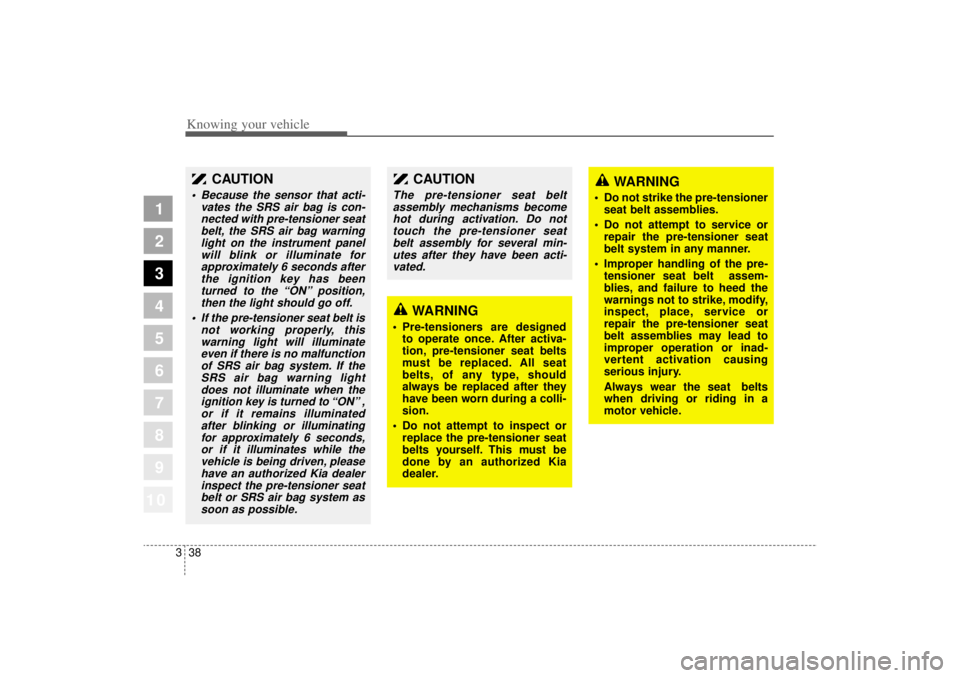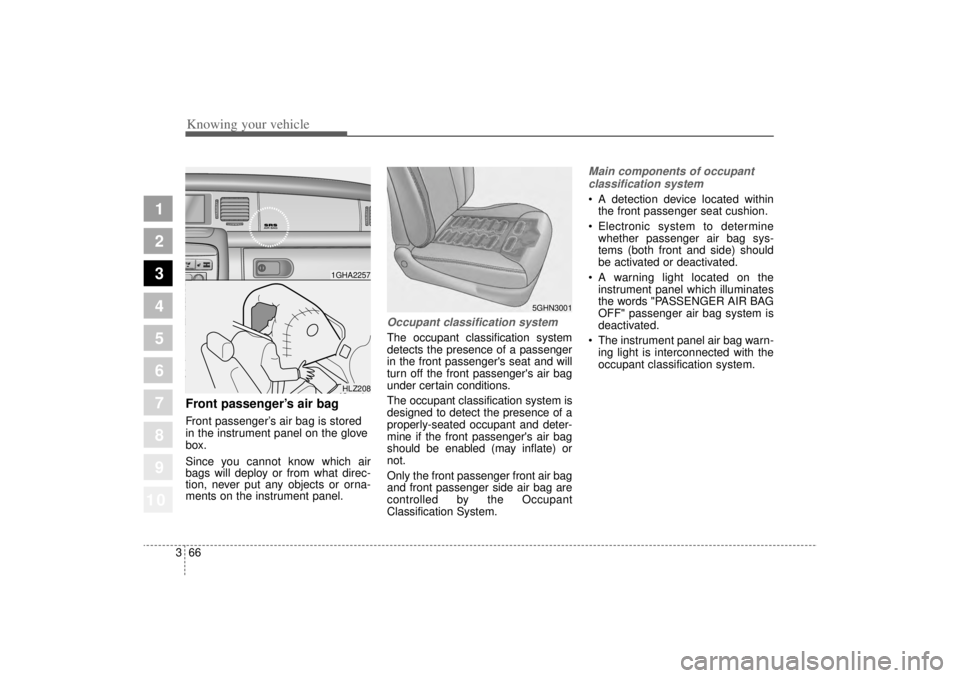Page 7 of 322
101
2
3
4
5
6
7
8
9
Exterior overview / 2-2
Interior overview / 2-4
Instrument panel overview / 2-5
Your vehicle at a glance
10
Page 10 of 322
10
Your vehicle at a glance42
1
2
3
4
5
6
7
8
9
INTERIOR OVERVIEW
1. Door lock/unlock button
2. Power window switches
3. Outside rearview mirror control switch
4. Seat adjust knob
5. Hood release lever
6. Parking brake pedal
7. Parking brake release lever
8. Instrument panel illumination
9. Steering wheel
10. Instrument cluster
11. Inside rearview mirror
12. Trunk release lever
13. Fuel filler lid release button
14. Seat
15. Master power door lock control
16. Master power window control lock
17. Brake pedal
18. Accelerator pedal
19. Vent controls
20. Steering wheel tilt
2GHN0005
Page 11 of 322
10
25
1
2
3
4
5
6
7
8
9
Your vehicle at a glance
INSTRUMENT PANEL OVERVIEW
1. Driver’s Air Bag
2. Light control / Turn signals
3. Instrument cluster
4. Wiper/Washer
5. Ignition switch
6. Seat warmer
7. Traction control system (if equipped)/ Electronic stability program (if equipped)
8. Hazard
9. Rear climate control selection button
10. Climate control system
11. Shift lever
12. Passenger’s airbag
13. Glove box
14. Trunk lid control button
15. Audio controls (if equipped)
16. Auto cruise controls (if equipped)
17. Coin holders
18. Multi-Function Display (if equipped)
2GHN0004
RES
ACCELCOAST
SETCRUISE
ON/OFFCANCEL
TCS
Page 18 of 322

37
1
2
3
4
5
6
7
8
910
Knowing your vehicle
Your vehicle is equipped with an
electronic engine immobilizer system
to reduce the risk of unauthorized
vehicle use.
Your immobilizer system is com-
prised of a small transponder in the
ignition key, and antenna coil in the
key cylinder and BCM (Body Control
Module) in the instrument panel.
With this system, whenever you
insert your ignition key into the igni-
tion switch and turn it to ON, the
antenna coil in the ignition switch
receives a signal from the transpon-
der in the ignition key and then sends
the signal to the BCM (Body control
Module).The BCM checks the signal and
determines whether the ignition key
is valid.
If the key is determined to be valid,
the engine will start.
If the key is determined to be invalid,
the engine will not start.
To deactivate the immobilizer sys-
tem:
Insert the ignition key into the key
cylinder and turn it to the ON posi-
tion.
To activate the immobilizer sys-
tem:
Turn the ignition key to the OFF posi-
tion. The immobilizer system acti-
vates automatically. Without a valid
ignition key for your vehicle, the
engine will not start.IMMOBILIZER SYSTEM (IF EQUIPPED)
Page 49 of 322

Knowing your vehicle38
3
1
2
3
4
5
6
7
8
910
WARNING
Do not strike the pre-tensioner
seat belt assemblies.
Do not attempt to service or
repair the pre-tensioner seat
belt system in any manner.
Improper handling of the pre-
tensioner seat belt assem-
blies, and failure to heed the
warnings not to strike, modify,
inspect, place, service or
repair the pre-tensioner seat
belt assemblies may lead to
improper operation or inad-
vertent activation causing
serious injury.
Always wear the seat belts
when driving or riding in a
motor vehicle.
CAUTION
Because the sensor that acti-
vates the SRS air bag is con-nected with pre-tensioner seatbelt, the SRS air bag warninglight on the instrument panelwill blink or illuminate forapproximately 6 seconds afterthe ignition key has beenturned to the “ON”position,
then the light should go off.
If the pre-tensioner seat belt is
not working properly, thiswarning light will illuminateeven if there is no malfunctionof SRS air bag system. If theSRS air bag warning lightdoes not illuminate when theignition key is turned to “ON”,
or if it remains illuminated after blinking or illuminatingfor approximately 6 seconds,or if it illuminates while thevehicle is being driven, pleasehave an authorized Kia dealerinspect the pre-tensioner seatbelt or SRS air bag system assoon as possible.
WARNING
Pre-tensioners are designed
to operate once. After activa-
tion, pre-tensioner seat belts
must be replaced. All seat
belts, of any type, should
always be replaced after they
have been worn during a colli-
sion.
Do not attempt to inspect or
replace the pre-tensioner seat
belts yourself. This must be
done by an authorized Kia
dealer.
CAUTION
The pre-tensioner seat belt
assembly mechanisms becomehot during activation. Do nottouch the pre-tensioner seatbelt assembly for several min-utes after they have been acti-vated.
Page 74 of 322

363
1
2
3
4
5
6
7
8
910
Knowing your vehicle
Air bag system components The main components of your SRS
are:
To indicate that your vehicle is
equipped with air bags, the corre-
sponding air bag covers are
marked with “SRS AIR BAG”.
- Driver’ s air bag (see page 3- 65)
- Passenger’ s air bag(see page 3-
66)
- Side air bag (see page 3- 72)
- Curtain air bag (see page 3- 73)
A diagnostic system that continual-
ly monitors the system operation.
An indicator light to warn you of a
possible problem with the system.
Emergency power backup in case
your car’ s electrical system is dis-
connected in a crash. The SRS uses a collection of sen-
sors to gather information about the
driver’
s and front passenger’ s seat
position, the driver’ s and front pas-
senger’ s safety belt usage and
impact severity.
The driver’ s and front passenger’ s
seat position sensors, which are
installed on the seat track, determine
if the seats are fore or aft of a refer-
ence position. Similarly, the safety
belt usage sensors determine if the
driver and front passenger’ s safety
belts are fastened. These sensors
provide the ability to control the SRS
deployment based on how close the
driver’ s seat is to the steering wheel,
how close the passenger’ s seat is to
the instrument panel, whether or not
the safety belts are fastened, and the
severity of the impact.
(Continued)
If your vehicle has been sub-
jected to flood conditions (e.g.
soaked carpeting/standing
water on the floor of the vehi-
cle, etc.) or if your vehicle has
become flood damaged in any
way, do not attempt to start
the vehicle or put the key in
the ignition before discon-
necting the battery.
Disregarding this precaution
may cause air bag deploy-
ment, which could result in
serious personal injury or
death. If your vehicle is sub-
jected to flooded conditions,
before starting the vehicle,
have the vehicle towed to an
authorized Kia dealer for
inspection and necessary
repairs.
Page 75 of 322

Knowing your vehicle64
3
1
2
3
4
5
6
7
8
910
The advanced SRS offers the ability
to control the air bag inflation with
two levels. A first stage level is pro-
vided for moderate-severity impacts.
A second stage level is provided for
more severe impacts.
According to the impact severity,
seating position and safety belt
usage, the SRSCM (SRS Control
Module) controls the air bag inflation.
Failure to properly wear safety
belts can increase the risk or
severity of injury in an accident.
Additionally, your SRS is equipped
with an occupant classification sys-
tem in the front passenger’ s seat.
The occupant classification system
detects the presence of a passenger
in the front passenger’ s seat and will
turn off the front passenger ’s air bag
under certain conditions. For more
detail, see “Occupant Classification
System” later in this section.
CAUTION
If the seat position sensor is not
working properly, the SRS airbag warning light ( ) on theinstrument panel will illuminateeven if there is no malfunctionof the SRS air bag system,because the SRS air bag warn-ing light is connected with theseat position sensor. If the SRSair bag warning light does notilluminate when the ignition keyis turned to the "ON" position, ifit remains illuminated afterblinking for approximately 6seconds, or if it illuminateswhile the vehicle is being driv-en, have an authorized Kia deal-er inspect the seat position sen-sor and the advanced SRS airbag system as soon as possi-ble.
AIR
BAG
WARNING
Modification to the seat struc-
ture can adversely affect the
seat position sensor and
cause the air bag to deploy at
a different level than should
be provided.
Failure to properly wear safety
belts can increase the risk or
severity of injury by causing
the air bags to deploy at a dif-
ferent level than should be
provided.
Do not place any objects
underneath the front seats
which could damage the seat
position sensor or interfere
with the occupant classifica-
tion system.
Do not place any objects that
may cause magnetic fields
near the front seat. These may
cause a malfunction of the
seat position sensor.
(Continued)
Page 77 of 322

Knowing your vehicle66
3
1
2
3
4
5
6
7
8
910
Front passenger’ s air bagFront passenger’s air bag is stored
in the instrument panel on the glove
box.
Since you cannot know which air
bags will deploy or from what direc-
tion, never put any objects or orna-
ments on the instrument panel.
Occupant classification systemThe occupant classification system
detects the presence of a passenger
in the front passenger's seat and will
turn off the front passenger's air bag
under certain conditions.
The occupant classification system is
designed to detect the presence of a
properly-seated occupant and deter-
mine if the front passenger's air bag
should be enabled (may inflate) or
not.
Only the front passenger front air bag
and front passenger side air bag are
controlled by the Occupant
Classification System.
Main components of occupant
classification system A detection device located within
the front passenger seat cushion.
Electronic system to determine
whether passenger air bag sys-
tems (both front and side) should
be activated or deactivated.
A warning light located on the
instrument panel which illuminates
the words "PASSENGER AIR BAG
OFF" passenger air bag system is
deactivated.
The instrument panel air bag warn-
ing light is interconnected with the
occupant classification system.
5GHN3001
1GHA2257HLZ208